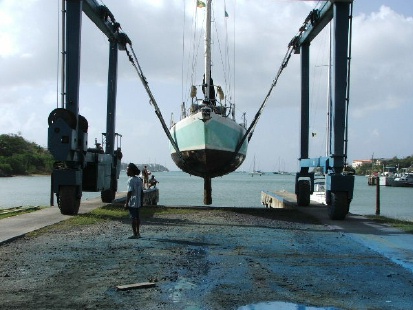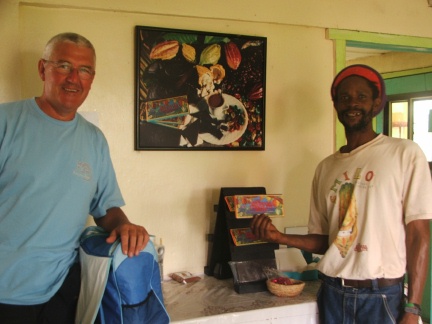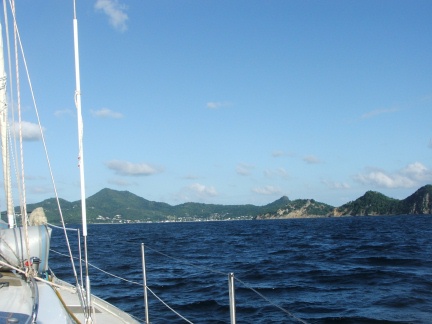
Light Blue hauled out
for a clean-up
Living the Dream
Windward Islands
On looking back at our log book for our voyage from Barbados to Grenada, on 10 and 11 January, it was a very uneventful trip, with hardly any remarks at all, apart from ‘Weather rainy, wind up to 23 knots in squalls. Great for cleaning the boat, sails and us. It makes a pleasant and cool change to have torrents of rain’.
The day after we left Barbados, we anchored in another country, in seven metres of turquoise clear water in Prickly Bay on the south coast of Grenada and settled ourselves in the cockpit to survey the surrounding anchorage, in which there were about 100 boats, comfortably spread out across the bay. It is delightful. The Windward Islands pilot book describes it thus: ‘The land is a tapestry of attractive gardens that form a background of green, speckled with bright flowers. Lovely homes and all kinds of roofs peek over the vegetation. At the head of the bay is a palm-fringed beach. You feel very much in the country here, with the sound of birds by day and tree frogs by night.’ I could not have described it better myself.
What photographs and narrative do not give you directly is the constant heat, with temperatures of 75 °F (24 °C) at night and 85 °F (29 °C) during the day, but with cool breezes wafting down from the mountains in the centre of the island. The waters of the bay are relatively clear despite the number of cruisers anchored and the swell is negligible, gently rocking us to sleep, instead of throwing us from side to side. Apart from the soothing natural sounds of the day and night it is peaceful, save for when a band is playing at the Boatyard on a Friday night at Happy Hour (well actually happy two hours from 5 till 7. With a large rum and coke at $10 EC (Eastern Caribbean) (£2 in real money), it is easy to return to one’s yacht in a silly, giggly, mood, for those who know me.
The Grenadian people are very helpful, friendly and happy, open-faced and not shy. Having been here for over a month, apart from a week or so, when we visited the next island, Carriacou, I know the people to be fair in trading and willing to compromise and barter if necessary. With a fair rate of exchange, food and drink are very reasonable, when one is on a cruising budget (i.e. my pension). Taxi fares seem expensive, but only when one compares them with the fares on the Hiace vans ($2EC) from one point to another. As long as you don’t mind being crammed into a ever-reducing space, with half the island’s population, the Hiace vans, with their heavy Rasta or rap music, relaxed but fast driving and businesslike attitude to picking up fares are very cheap. We use them all the time, apart from when we’re walking.
In stark contrast to Barbados, where there was virtually no facility for yacht cruisers, we are catered for extremely well, with two large chandlers (Budget and Island Water World), two large boatyards (Spice Island Marine and Grenada Marine), sail lofts, stainless steel works and wood workshops. We have been so impressed with the standard of service that we are getting those jobs, which we were intending to complete in the USA, done here, where one knows one will not be ripped off. On two occasions on the island, where we have had work done, the separate companies have actually charged half hours, rather than rounding it up, as would happen in the UK.
Spice Island
It is also very pleasant to see locals and Europeans working alongside each other in a non-confrontational yet friendly competitive way.
Siobhán has just returned from her visits to Ireland and the UK and we have hauled the boat (taking it out of the water) at Spice Island Marine Services boatyard for four days. Whereas before we left Plymouth, we did all the antifouling and topsides polishing ourselves to save on the outrageous costs, we left the cleaning, filling and antifouling of the hull to the locals here, while we looked after the rest of the boat. Because Siobhán had been away for her birthday and Valentine’s Day, and I wanted to give her a treat, I booked us into an air-conditioned holiday flatlet for the four nights. It was well-equipped with kitchen-diner, cooker, fridge-freezer, bathroom with shower, seven-foot king-size bed and cable television. After finishing work on the boat, we would walk home, shower all the dust and heat away and then relax for the evening. In this way, we were fresh to start work the next day. Fellow yachtsmen staying on their boats in the yard said they were plagued by mosquitoes at night. Getting away from the boat also enabled us to enjoy the pleasures of the island, but I should say enjoy the island some more, since we had already toured through Grenada and also Carriacou and that is what I will cover next. Please bear in mind that the tourism has been interrupted somewhat due to Siobhán’s unscheduled return to Europe.
As we are travelling, we have been assisted greatly by the pilot books we carry with us for each part of the world we are visiting. They not only give one guidance to the regulations in various countries of the world, but also navigational aid, yacht directions and places of interest, which will make a stay more interesting. We read these pilots as we are sailing along and decide beforehand what we would like to visit and how we will go about it in the most economical way.
It is worthwhile remembering that while we have embarked upon what many people who know us would regard as a luxury cruise, it is far from that and at times, 95% of normal people would baulk at what we endure. The unpleasant things I haven’t told you about such as the mosquitoes, the no see-ums (midges), the restricted quarters, having to pump your toilet, the local smells, distance from our friends and family, the lack of Eastenders and things you take for granted are all issues, which we accept as part of travelling away from civilization as we know it in Europe. But hold on, now that is a laugh, because it is more civilized here, with respect for law and order, smart and polite schoolchildren, polite shop workers who put the customer first, people who put people first and are willing to put themselves out for you. I remember when it was like that in England. Anyway mon, that’s enuff politicking, init!

Lawry with Edmund from the
Grenada Organic Chocolate Factory
Grenada
Moored as we are in Prickly Bay, we are only 15 minutes by taxi/ Hiace from St George’s, the capital of Grenada, so we travelled to the capital and wandered about the cruise terminal Mall (so like others) and then visited the markets, which are so colourful, noisy, communicative and competitive. The emphasis on Grenada, which is known as The Spice Island, is on selling spices and, in particular, nutmeg, which comes from Grenada. Mace, which we also use in our cooking, is the outer part of the nutmeg. Luckily for us, we had already spoken with a friendly lady and purchased our requisite spices from her while receiving a religious lesson at the same time. No harm done.
We also, by way of introduction and finding our way around, went to the central bus station. How to describe it! Noisy, crowded, dark as a dungeon, filled with waiting people, but organized in a local way. Everybody is willing to help with the number of the bus to catch for certain destinations, but without there being any semblance of authority to govern this friendly crush of humanity disappearing from the centre to their various suburbs. The buses hold about a dozen but there is always room for an extra one and the ‘conductors’ are so inventive. Once on the bus, the way to indicate you want to get off, is to tap with your knuckles on the frame of the vehicle, ‘rap rap’. It might mean that five passengers have to get off to let you off, as there is only one way on and off, but it works for everyone without moaning. We have entered into some very pleasant conversations with fellow passengers, who want to know where we’re from and we want to know about their island, of which they are justifiably proud.
A couple of days later we returned and sought out the bus for Grenville, on the east coast, from where we had to catch another bus to the Grenada Chocolate Factory, where they make Organic 75% cocoa chocolate, you know like the more familiar Green and Blacks, but mmmh! So much better. We were going on to two other destinations after that, the Belmont Plantation and the River Antoine Rum Factory. The bus driver from Grenville actually went out of his way (and that of his passengers) to drop us at the door of the chocolate factory. Having had a relaxed tour of the factory and samples and purchases, we walked down the hill to the plantation, where we were given a most informative description of the development of Belmont since it was virtually wiped out in the recent hurricanes. We were shown an array of exotic fruit and vegetables, which they are now producing there, plus they produce the cocoa beans for the factory up the road. We were shown the pods from which the raw beans come, the fermentation stalls, the drying beds, with the beans being shuffled by the workers walking through them in their bare feet and final processing into the cocoa we know. Such enterprise and determined and free spirit.
Suitably impressed, we walked further down the hill into the next village and we were just chatting to a local man when by chance we picked up a passing Hiace going to River Antoine. This rum distillery uses exactly the same systems and equipment it was using 200+ years ago. The water mill, which grinds the sugar cane bears the name C. Fletcher of Derby and London. At the end of the tour we were given a teaspoonful of their strongest rum (initially I thought they were being tight-fisted). It is 75º alc/volume, which equates to about 135 proof. You could feel it going all the way down. I pointed out to the tour guide a leak in one of the pipes. It was eating a hole in the floor. A teaspoonful is enough.
Tyrell Bay
We returned across the island from the north-east to the south-west, satisfied that we had had an interesting day. The drive there and back through the mountains was more exciting than a white-knuckle ride at Alton Towers, the extreme fun fair in England. The only downside to the speed and the cramped condition in the Hiace is that you only glimpse some of the island scenery.

Tyrell Bay, Carriacou Island
Before Siobhán flew back to the UK and Ireland, we had already begun our move northwards and sailed away from Grenada and to Tyrell Bay in Carriacou, the next island north of Grenada. We settled ourselves in this bay surrounded once again by a multi-national fleet of yachts of all different shapes and sizes, but in a much tighter formation. In the days we were there we were happy and continued to go ashore and explore on foot the close environs of the bay. We had refreshing drinks in the yacht club where tethered goats graze in the garden and two elegant cats recline in the shade of the patio. We walked to Paradise Beach and sampled its sandy splendour and crystal clear waters overlooking Sandy Island, a mini atoll, where a handful of yachts were anchored. We stopped at Joe the Rastaman’s Bar and refreshed ourselves while he told us of his visit to Acton in West London, a far cry from this virtual paradise. He told me of the small family of Rastas, who resided there and of their happiness in the simple communal life. Somehow, I knew he had found the meaning of life for himself. Respect!
In Tyrell Bay, we met boat boys for the first time. They were actually middle aged, two selling bottles of Chilean wine for $15EC each (£3) and one selling limes, with whom we traded (the limes were miniatures but lasted for over a week). He also offered oysters and as Siobhán does not eat seafood and I visualised fresh fat juicy oysters, I ordered half a dozen for the following day.
When he arrived the following afternoon, he asked for a sharp knife to cut them open, but having proffered the knife, I then saw the oysters!! How to describe them, when one is accustomed only to big healthy oysters. Please excuse my ignorance of what to expect of mangrove oysters. The two halves were similar to two thin pieces of slate, which looked as if they had been covered in diesel. When he opened the first one, the oyster itself looked no bigger than an immature cockle. I was most disappointed and said that I did not want them or to pay the $20EC.
He gave me a diatribe about the amount of time he had spent gathering this paltry fare and virtually demanded recompense, which I gave him. A Carib beer and $5EC almost satisfied him. Methinks it is the shape of things to come. Probably the worst aspect of the boat boys is the dilapidated state of their boats, with rough and ready rubbing strakes, showing rusty nail heads, which rock into one’s polished topsides, while their boating skills are otherwise distracted by the thought of your money.
I wouldn’t mind if they had something worthwhile to sell and one could arrange fenders alongside at appropriate moments, but thinking positively perhaps their standards will improve as we head north. I suppose that it is all part of the local colour and culture, for which we travel to foreign climes and one should not expect the perfection in fruit, vegetables, steaks and seafood, which one expects from supermarkets back home.
Windward Beach
One of the most pleasant trips we took on Carriacou was to Windward in the north-east of the island, which overlooks the smaller islands of Petit Martinique and Petit St Vincent (PSV). This Atlantic coast is littered with the hulks of ships wrecked on the coral reefs. We caught a Hiace from the town centre of Hillsborough, the capital of Carriacou, to the end of the island and walked back part of the way, detouring onto Windward Beach along a path lined with conch shells and potholed with crab burrows. When we finally reached the beach, we were alone and walked along surveying the sands for treasures. At the end of the beach was a shipwreck, and at the tide line there were literally dozens of shattered conch shells, pieces of dead coral and even some coral fronds thrown up by the harsh Atlantic rollers. Nature’s hooliganism. We walked back to the road and along it to the main village, where traditional wooden boats are still made on the beach and coloured in the local national colours of green, yellow and red. The locals actually race these sailing skiffs on a regular basis.
And what did I do when Siobhán was in Europe for three and a half weeks? Apart from changing the oil in the engine, varnishing the brightwork, at least three times, cleaning the teak, scrubbing the waterline of ‘Light Blue’, regularly, because of the rapid growth of weed, I had the battery and electrical system checked out professionally and took the outboard apart to clear water in the carburettor. I walked five miles a day to keep fit, bought provisions and cooked for myself daily, spent ages trying to find presents for Siobhán’s birthday and Valentine’s Day, socialized once a week on Friday’s happy hour, gave up drinking rum and coke and read two excellent books. I planned our next year’s sailing and wrote to the insurance company to approve our itinerary (successful at a reduction of premium), read pilot books to plan our next stops up the Caribbean and spoke to Siobhán daily. I went to bed by 9 p.m. and was awake by 6 a.m. Yes, as usual, I was an absolute angel.
Today, 10 March 2007, the day after we re-launched the boat, we have filled her with diesel (68 gallons at a cost of $748EC, i.e. $11EC per gallon or £2 per gallon [40p per litre]). We are re-provisioned, the boat is gleaming and ready to go to sea again. We cannot wait. It has been a frustrating two months, but due to Siobhán’s strength and tenacity, finally satisfying.
Northwards we travel, through the Windwards and Leewards, to the British Virgin Islands, then past the Bahamas on the Atlantic side to Jacksonville, in the north of Florida, up the intra-coastal waterway to Norfolk, Virginia, explore Chesapeake Bay, then through to Delaware Bay and up the coast to New York, with a relaxing detour to Toms River, New Jersey, some time in the summer of 2007. In New York, we will sit and decide where we are going for the following six months, before turning back to Europe? Or elsewhere?
Watch this space!
Love from Siobhán and Lawry
Still living the Dream, February-March 2007
Read previous adventures in the ... Archives
... and see the latest photographs
